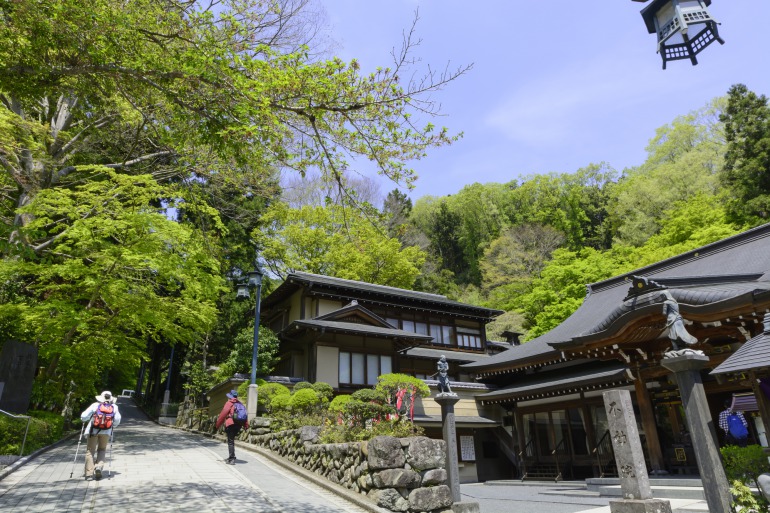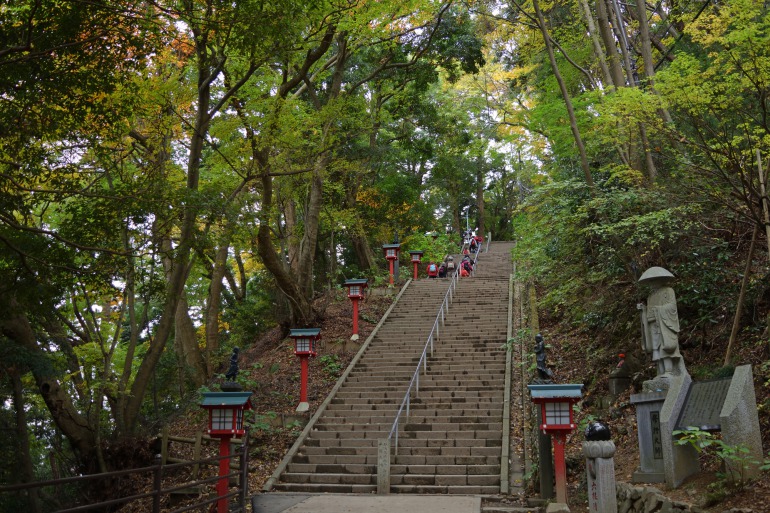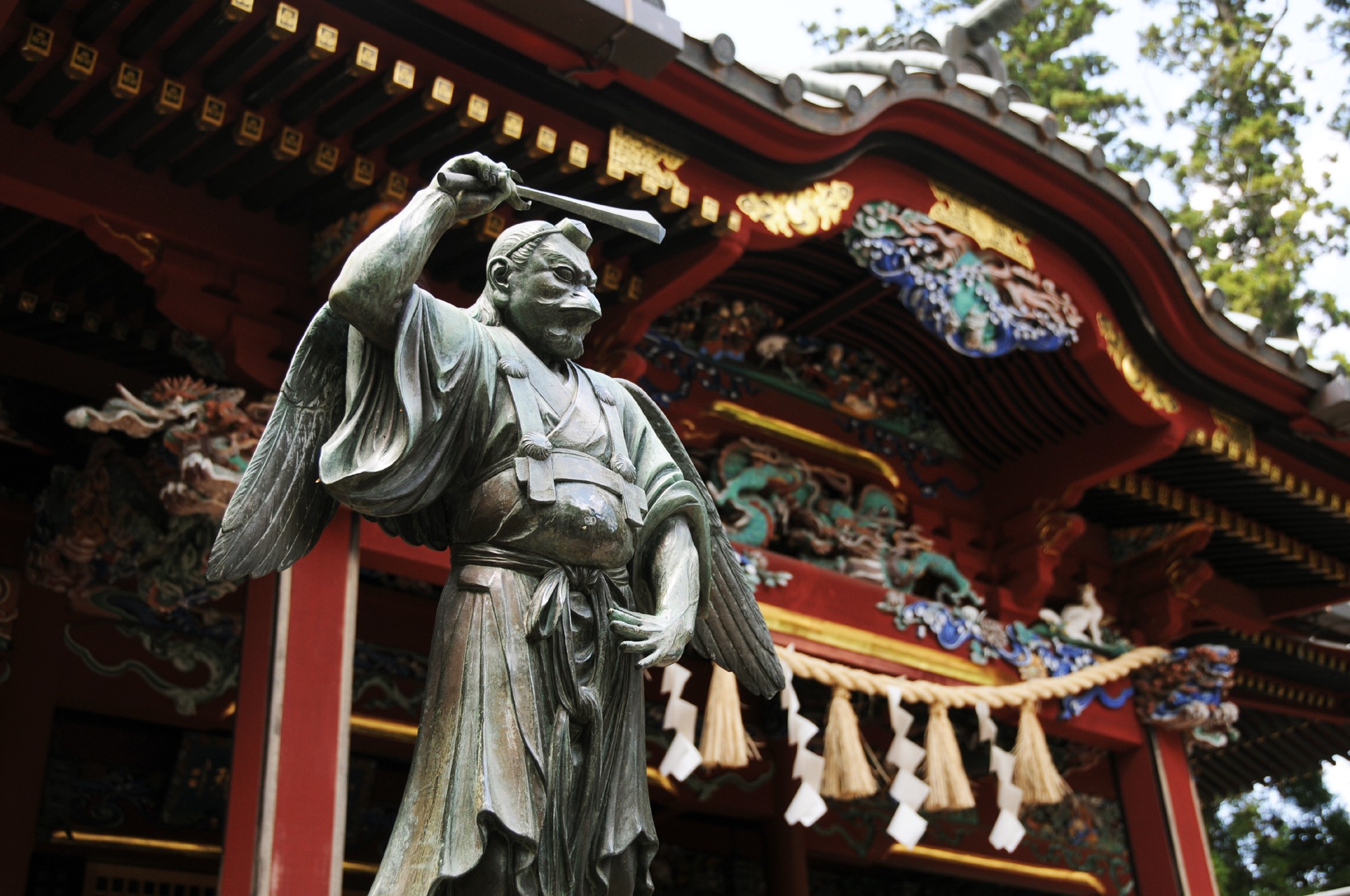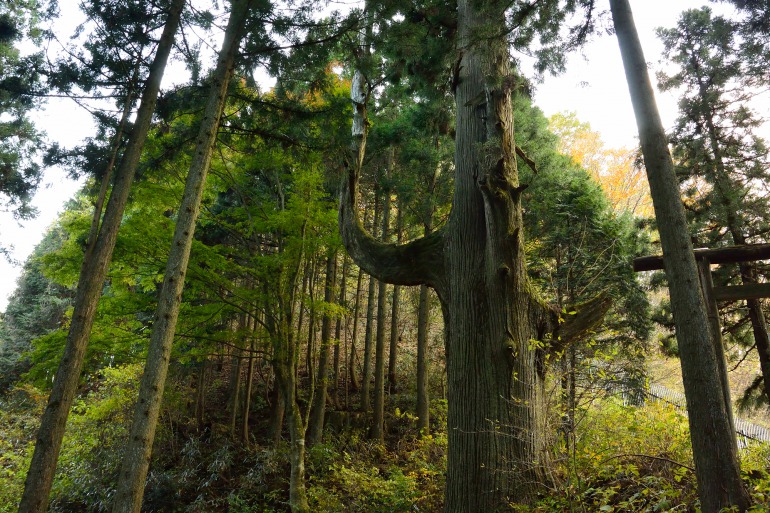With its lush nature, varied activities and extremely easy access from Shinjuku, Mount Takao in Tokyo is a hugely popular destination for weekend outings and hikes. Its popularity spiked even further with its achievement of 3 Michelin stars in 2007, and Mount Takao now attracts nearly 3 million people annually.
Mount Takao has 8 hiking courses catered to hikers of all levels, and nearby venues including a hot spring and museum, make the Mount Takao a great destination for any fun-seeking traveler.
This article will introduce Mount Takao's 8 hiking courses, anecdotes behind its dense greenery, and 6 must-see spots hidden within it!
History of Mount Takao
Mount Takao in early Japan
Mount Takao has a long history as a Sacred Mountain. It dates as far back to 744, when Emperor Shomu asked a Buddhist priest, Gyogi, to build a temple specializing in praying for the country’s peace. This was the origin of Takaosan Yakuo-in Temple, and since then, it has become a temple tradition to hold ascetic practices in the mountain. One famous practice in particular is the takigyo, where one stands below a waterfall to clear his mind while withstanding the force of the water.
In 1375, a priest from Kyoto visited Mount Takao for the purpose of restoration, as it had been unused and eventually devastated. This is when the statue of Izuna-daigongen, the central figure of worship at Mount Takao, was brought and dedicated to Yakuo-in. Along came the statue of the Tengu, a long nosed goblin, brought to accompany the Izuna-daigongen, which are both still worshipped at Mount Takao. In fact, the Tengu has grown to become a symbol of Mount Takao.
The Warring States Period (1467 - 1568) through the Edo Period (1606 - 1868)
As Japan enters the Warring States Period (around 1467 – 1568), Mount Takao became home to the Hojo family, one of the most powerful warrior families at the time. The Hojos strictly protected Mount Takao by prohibiting cutting down trees in the area.
After the Hojo family’s fall under Toyotomi Hideyoshi’s rule, Mount Takao became Tokugawa Ieyasu’s (one of Hideyoshi’s pupils) property. Ieyasu too took a great amount of care in protecting Mount Takao, and the conservation efforts continued into the Meiji Restoration era.
From the Showa Period and on (1926-present)
In 2007, Mount Takao accomplished the feat of receiving three stars in Michelin’s Travel Guide. The main reason was the well-conserved nature on the premises, despite it only being one hour away from Tokyo’s metropolitan area. Mount Takao and Mount Fuji are the only two mountains in Japan receiving the three star rating.
As Mount Takao is somewhere in between the temperate and frigid climate zone, a myriad of types of plants grow in the area. Each season provides a different offering and a unique view. Mount Takao has grown to become one of the most popular tourist spots in Tokyo and in Japan, as a result of the deliberate care of the area by the ancestors of the country.
8 Trekking Courses for both Beginners & Experts
Mountain climbing may sound like a delightful outdoors activity to some, but for others it could sound like a bit of a drag. Mount Takao is a great mountain climbing destination, as there is a route for everyone, ranging from slower, more recreational itineraries to hard-core mountain climber trails.
There are eight courses in total to choose from, with a good portion of them being family-friendly. At a height of 599 meters, Mount Takao is just the right height for mountain climbing novices and regulars.
Route 1: Omotesando Course

Route 1
This is the most popular course for visitng tourists. At a glance, the 3.8-kilometer route may seem a bit intimidating in length, but the roads are well paved and the course is recommended for beginners. This course passes through many of the main tourists spots like Yakuo-in, the Monkey Park, observatories and restaurants.
Route 2: Kasumi-dai Loop Course
Although this course does not reach the top of Mount Takao, it is still a popular course as it is only 1 kilometer long and takes roughly just 30 minutes to complete.
The Kasumi-dai Loop course is just as it sounds; it circles an area around the mid-way point of Route 1, the Omotesando Course. Within this route, you can see several different types of nature, such as the evergreens in the temperate zone in the southern part and the coniferous trees in the frigid zone in the northern part
Route 3: Katsura-bayashi Course

View from Route 3
The third route, the Katsura-bayashi Course, starts near the middle of Route 1. With only a few ups and downs, this 2.4-kilometer course is on the more gentle side. This route is rich in nature, with lush forests surrounding your way to the pinnacle of Mount Takao. Towards the end, this course joins routes with courses 5 and 6.
Route 4: Suspension Bridge Course
This is a special course that allows you to cross Miyama-bashi, the only suspension bridge on Mount Takao (hence the title of the course). The 1.5km journey begins at the north side of Joshin-mon, and heads in an opposite direction from Route 3. In autumn, this route is especially beautiful, as the leaves on the many trees change colors into stunning hues of reds and oranges. You will reach the top of the mountain after going up a flight of stairs.
Route 5: Peak Loop Course
As the name of the route states, this course leads you in a loop around the peak of Mount Takao. This route specifically is more historical than the others, as it is said that the Egawa cedars planted throughout the course were planted during the Edo period.
The 1-kilometer loop only takes 30 minutes and connects with all other routes (with the exception of Route 2), so you can stop by this course before heading down on your original route. Winter is the prime time for this course, as you can witness the “ice flower” phenomenon shown below.
Route 6: Biwa-Taki Course
If you are confident in your mountain-climbing skills, this course is a great challenge. A 3.3-kilometer adventure, the Biwa-Taki course is a jagged route. In contrast to the rocky roads, the small rivers will provide relaxation as the waters orchestrate a soothing tone.
Summer is the perfect season for this course, as you can stop by the Biwa-Taki waterfall for a cooling break. With wooden stairs and stepping stones along the way, the Biwa-Taki course is a unique and fun route.
Route 7: Inariyama Course

View from Inariyama
Starting with a heavy hill hike, the Inariyama course is also for the more experienced climber. This route runs over the ridge of the southeast part of Mount Takao, and boasts an observatory in the middle of the route.
The Inariyama observatory is located mid-course, and provides a magnificent view that is sure to recharge you for the rest of the course. Most of the roads are unpaved, and this particular route is great for those who want a tougher mountain-climbing experience.
Route 8: Jimbayama Course
For some real trekking, this is the best course. The Jimbayama Course leads you through Mount Takao, Mount Shiro, Mount Kagenonbu and Mount Jimba (in order). As you hike through these many mountains, you get to experience the different views from each of them. This is quite a lengthy course, taking more than 5 hours to complete, but with several rest stops in between you will have plenty of opportunities to rest.
The long trek is definitely worth it, as you get to see a panoramic view of Tokyo from Mount Jimba (850 meters high)! With cherry blossoms in the spring and maple trees in the fall, this scenic route is terrific for those up for a trekking trip.
6 Spots to Visit during your Mount Takao Trek
The Monkey Park & Wild Plant Garden

A Japanese Monkey at the Monkey Park
Just 5 minutes from Takaosanguchi station (the nearest station to Mount Takao), there is the Monkey Park and the Wild Plant Garden.
The Monkey Park is home to 70 monkeys, and the monkeys run around and roam freely in the park.
In the Wild Plant Garden, there are over 300 types of flowers and plants. The climate of the Mount Takao is a wide mixture of warm temperate and frigid climates, making it possible for many different types of flowers and plants to blossom throughout the year.
One ticket allows entry for both parks, and is ¥420 for adults and ¥210 for children.
The Joshin-mon Gate Greets Hikers

Joshin-mon
The large, divine gate you pass through as you begin your Mount Takao hike is the Joshin-mon (literally translating to “soul-cleansing gate”). This gate is at the halfway point of the Omotesando route (the one continuing to Yakuo-in). There is only one road to the Joshin-mon, but it splits into four different courses after passing the gate.
Otoko-zaka & Onna-zaka

Otoko-zaka(108 steps)
Just after starting the Route 1 hike, the course temporarily splits into 2 smaller roads – the Otoko-zaka (man hill) and Onna-zaka (woman hill). The “man hill” on the left side is composed of 108 stone steps, symbolizing the 108 earthly desires in Buddhist teachings. Going up each of the steps is supposed to rid the earthly desires one at a time.

Onna-zaka
The hill on the right, the “woman hill” is less steep but longer in length, and is better for enjoying the nature that surrounds Mount Takao.
The 1,200-Year Yakuo-in Temple

Yakuo-in Temple
The Yakuo-in is a temple located in the middle of Route 1, and has a history of over 1200 years. This temple, built by a Buddhist priest, is one of the most significant buildings within Mount Takao grounds.

Tengu statue
In Japan, Mount Takao is often associated with the Tengu, and this temple is the reason behind it. When this temple was going desolate, a priest brought over a statue of the god Izuna-daigongen, and along with it came a statue of the Tengu. The Izuna-daigongen is known as the god of military generals, and has ties with famous generals such as Tokugawa Ieyasu, Takeda Shingen and Uesugi Kenshin. The Tengu, which holds the special power to help people out of confusion into enlightenment, served as an attendant of Izuna-daigongen, and ever since has been a fond figure at Mount Takao.
Miyama-bashi

Miyama-bashi
The Miyama-bashi is the suspension bridge found on Course 4. This bridge, which is the only suspension bridge on Mount Takao, will make you feel as if you are walking in mid air and give you that extra jolt of adrenaline. Families and couples especially enjoy the thrilling experience, and it is also a great spot for photos.
The Sacred Waterfalls: Biwa-taki and Ja-taki

Biwa-taki
As a holy mountain, Mount Takao is famous for its takigyo, or waterfall training. This Buddhist training consists of standing under a waterfall and clearing your mind for enlightenment. Ever since the myth of a Buddhist priest achieving enlightenment while practicing takigyo at Biwa-taki, this has been a popular takigyo spot.
The 100+ Year Old Cedars of Mount Takao
As mentioned above, the unique climate on Mount Takao is a mixture of warm, temperate and frigid, creating the perfect environment for many different plants to coexist. In the area, cedar trees are especially well known, and many of the planted cedars are over 100 years old.
The "Tengu Chair Cedar"

700-year old cedar tree
On Course 1, there is an especially prominent cedar tree, and it is approximately 700 years old. This cedar tree is nicknamed "Tengu Chair Cedar", and is said to be home to a Tengu (a folklore creature of the mountains) who watches over the visitors for their safety. This sensational cedar tree is located near Yakuo-in Temple .
The "Egawa Cedars"
As you circle around Course 5, you will find the forest of cedars named the "Egawa cedars". These trees are said to have been planted in the Edo period, and many tower over 40 meters.
The "Octopus Cedar"

The octopus cedar
Another famous tree on Course 1 is the Tako-sugi, or octopus cedar. This tree, planted over 500 years ago, is called the octopus cedar due to its lanky and lengthy roots resembling an octopus’ tentacles. The octopus figurine at the base of the tree is called the “Hipparidako”, and rubbing its head supposedly brings you good luck.
The 3 Observatories of Mount Takao
Mount Takao Mountaintop Observatory

Mount Takao Mountaintop Observatory
There are three observatories at Mount Takao, and one lies at the very peak. On clear days, this observatory will give you a full view that even includes Mount Fuji. There is a rest area here too, making it a great place for a lunch break.
Kasumidai Observatory

View from Kasumidai Observatory
Another observatory is the Kasumidai observatory. Located on Course 1, the Kasumidai observatory offers a breathtaking night view of Shinjuku’s skyscraper district.
Inariyama Observatory
The third one, the Inariyama observatory, is only accessible through the Inariyama route. Since the Inariyama route is on the tougher side, it may be a bit of a challenge, but it is definitely worth a try. There is a resting area at the observatory, so you can take a breather here.
Events at Mount Takao
Hiwatari Festival (Mar.)

Hiwatari Festival
Hiwatari is a tradition held at many temples, where one must walk and cross through burning wood while chanting Buddhist sutra. The Hiwatari festival held in Mount Takao is one of the biggest of its kind, and prays against natural disasters, for world peace, health, and longevity. This event is for both priests and visitors, so you too, could experience walking through fire. This event is held on the second Sunday of March.
Mount Takao Wakaba Festival (Apr. to May)
To celebrate the coming of spring, the Takaosan Wakaba Festival is held annually in April and May. With concerts, street performances and food vendors, you can enjoy the Japanese festival spirit. You can also witness nodate, which is a traditional outdoors tea ceremony. For details, check the official website.
Mount Takao Beer Mount (June to Oct.)
At the observatory deck located right at the cable car exit, there is a beer garden open every summer. From June to October, you can enjoy various kinds of beers and other drinks (non alcoholic too) as well. There is a buffet available, popular with families and children. With three seating areas (two outdoor and one inside), the Takaosan Beer Mount is sure to be a blast rain or shine.
Access to Mount Takao
Nearest Station: Takaosanguchi Station 高尾山口駅 (Keio Line KO53)
Access from Shinjuku Station 新宿駅
【Shinjuku Sta.】Keio Line / for Takaosanguchi
→【Takaosanguchi Sta.】about a 5-minute walk
Access from Tokyo Station 東京駅
【Tokyo Sta.】JR Chuo Line Express / for Shinjuku
→【Shinjuku Sta.】Keio Line / for Takaosanguchi
→【Takaosanguchi Sta.】about a 5-minute walk
Access from Narita Airport 成田空港
【Narita Airport Sta.】JR Narita Line Narita Express / for Shinjuku
→【Shinjuku Sta.】Keio Line / for Takaosanguchi
→【Takaosanguchi Sta.】about a 5-minute walk
Access from Haneda Airport 羽田空港
【Haneda Airport Sta.】Keikyu Line / for Shinagawa
→【Shinagawa Sta.】JR Yamanote Line / for Shibuya
→【Shinjuku Sta.】Keio Line / for Takaosanguchi
→【Takaosanguchi Sta.】about a 5-minute walk
Perfect for a Casual Outing

Sign by Mount Takao
Due to its lush nature and great access from Tokyo's city center, Mount Takao is a great destination to experience Japan's nature within the metropolitan reach of Tokyo. Whether it's a weekend date or family outing, Mount Takao has you covered. The mountain has received a Michelin 3-star rating in 2007, and boasts an annual hiker count of nearly 3 million - that's the highest of any mountain in the world!
One after another, museums and hot spring facilities have been opening up near Mount Takao, making it an even more attractive destination for a variety of traveler needs including full-fledged hikes, casual picnics, or hot-spring hopping.
Mount Takao is a mountain overflowing with activity with landmarks full of charm, and is sure to make a great addition to your travel itinerary!
Information
Takaosan, Takao-cho, Hachioji, Tokyo
042-661-4151
Free
http://www.takaotozan.co.jp/
.jpg)








_600x400.jpg)
_600x400.jpg)















_600x400.jpg)


